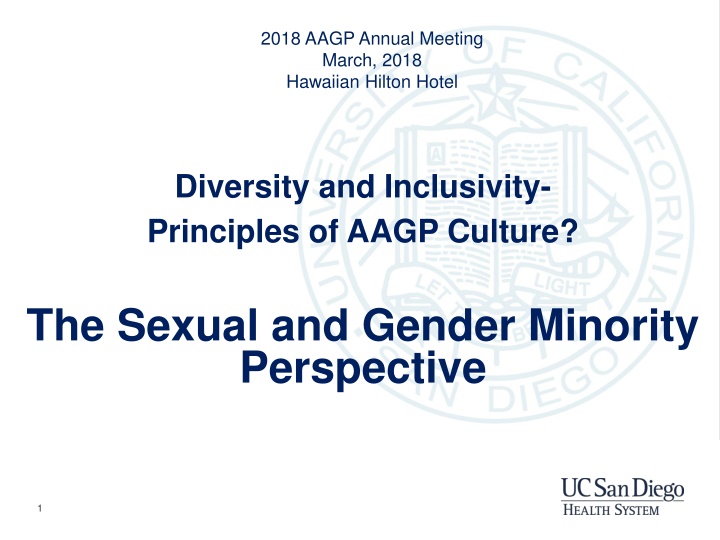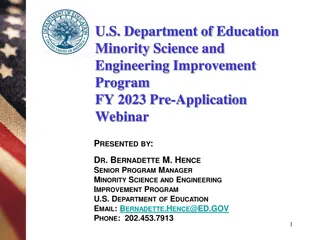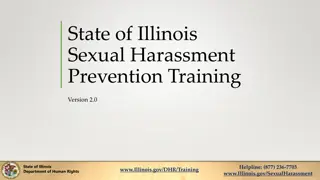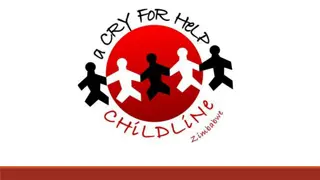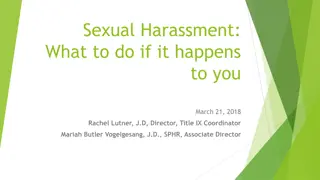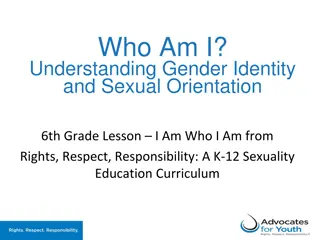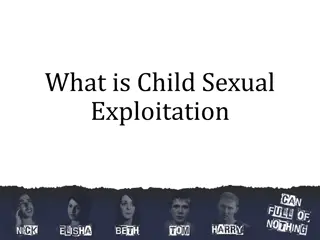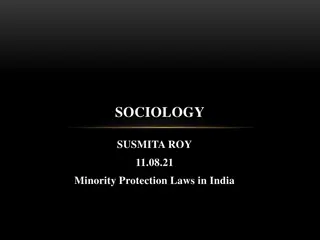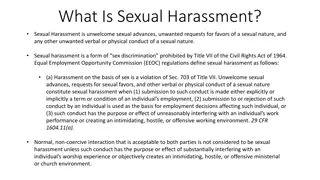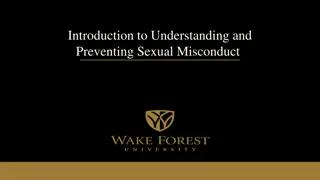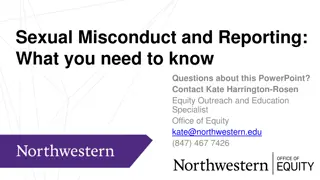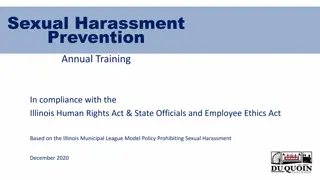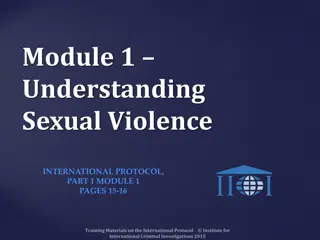The Sexual and Gender Minority Perspective
The presentation delves into principles of cultural competence in addressing diverse populations, organizational values, and self-assessment methods for healthcare organizations.
Download Presentation

Please find below an Image/Link to download the presentation.
The content on the website is provided AS IS for your information and personal use only. It may not be sold, licensed, or shared on other websites without obtaining consent from the author.If you encounter any issues during the download, it is possible that the publisher has removed the file from their server.
You are allowed to download the files provided on this website for personal or commercial use, subject to the condition that they are used lawfully. All files are the property of their respective owners.
The content on the website is provided AS IS for your information and personal use only. It may not be sold, licensed, or shared on other websites without obtaining consent from the author.
E N D
Presentation Transcript
2018 AAGP Annual Meeting March, 2018 Hawaiian Hilton Hotel Diversity and Inclusivity- Principles of AAGP Culture? The Sexual and Gender Minority Perspective 1
Daniel D. Sewell, MD, DFAPA Professor of Clinical Psychiatry Geropsychiatry Fellowship Program Director Emeritus Co-Director, Division of Geriatric Psychiatry Associate Vice Chair for Development and Geriatric Psychiatry Department of Psychiatry University of California, San Diego AND Past-President, American Association for Geriatric Psychiatry 2
DISCLOSURES Financial Medical Advisory Board, ActivCare Living Residential Memory Care, Inc. Research Support DHHS/HRSA Geriatric Workforce Enhancement Program Award 6/15 6/18 Title: The San Diego GWEP Collaborative Awardee/amount/role: UC San Diego/$849,197 per year/Geropsychiatry Educator PI: Diane Chau, MD DHHS/HRSA Geriatric Workforce Enhancement Program Award 6/15 6/18 Title: San Diego/Imperial Geriatric Education Center (SDIGEC) Awardee/amount/role: San Diego State University Foundation/Sub-award granted to UC San Diego, $841,108/year/Co-PI PI: Philip Greiner, DNSc,RN, Director, School of Nursing, SDSU 3
DISCLOSURES Other Uncompensated board member of the following organizations: Board of Directors, Brain Health Alliance Clinical Advisory Board of Ceresti Health George G. Glenner Alzheimer s Family Centers, Inc., San Diego, CA Medical Advisory Board of Alzheimer s San Diego (formerly) Medical Advisory Board, Alzheimer's Association San Diego/Imperial Chapter Medical Advisory Board of the San Diego Chapter of the National Alliance for the Mentally Ill 4
Self-Assessment of Organizational Cultural Competence PURPOSES: DIMENSIONS: 1) Know thyself 1) Members attitudes towards diverse populations. 2) Make a public statement that an organization values diversity 2) Staff and administrative performance 3) Measure how effective is the organization addressing the needs and concerns of the diverse groups they serve 3) Organization s policies (Mission, goals, hiring practices). 4) Physical environment 4) Find areas of strength and growth to allow strategic planning M. Olavarria. Organizational Cultural Competence in Community Health and Social Service Organizations: How to Conduct a Self-Assessment. Journal of Cultural Diversity, 2009. 7
Key Steps in the Assessment of Organizational Cultural Competence KEY STEPS: 1. Engaging in the assessment process a. Build a diverse committee b. Timeline c. Duties d. Obtains support e. Provide resources 2. Preparing stakeholders for the assessment a. Decrease anxiety and encourage participation b. Remind the stakeholders about the developmental process 8
Key Steps in the Assessment of Organizational Cultural Competence KEY STEPS: Conducting the self-assessment a. Gathering data Set standards and indicators for key areas Use a validated tool: 3. CulturalCompetence Self Assessment Protocol for Health Care Organizationsand Systems (CCSAP; Andrulis et al., 1998) Cultural CompetenceSelf-Assessment Questionnaire (CCSAQ; Mason, 1995) Cultural Competency Assessment Scale (CCAS; Siegel et al., 2002) b. Evaluation of results c. Reporting results d. Making recommendations about implementation and next self- assessment 9
Self-Assessment of Organizational Cultural Competence 10
Self-Assessment of Organizational Cultural Competence 11
Organizational Norms, Principles and Polices Mention of Cultural Competency in Mission Statement? Current: The American Association for Geriatric Psychiatry is a national association representing and serving its members and the field of geriatric psychiatry. AAGP promotes the mental health and well-being of older people through professional education, public advocacy, and support of career development for clinicians, educators, and researchers in geriatric psychiatry and mental health. Possible revision: The American Association for Geriatric Psychiatry is a national association representing and serving its members and the field of geriatric psychiatry. AAGP promotes the mental health and well-being of older people representing the full spectrum of races, ethnicities, faith communities, genders, sexual orientations and abilities through professional education, public advocacy, and support of career development for clinicians, educators, and researchers in geriatric psychiatry and mental health. 12
Organizational Norms, Principles and Polices AAGP cultural competency policy statements, code of conduct and established processes for implementation and monitoring of adherence? 13
Organizational Norms, Principles and Polices AAGP leadership and staff commitment to cultural competency? The theme of the 2018 annual meeting: Diversity and Inclusivity: Achieving Excellence in Geriatric Mental Health was selected by our current president, Ike Ahmed AAGP Statement on Immigration Executive Order February 7, 2017: Excerpt: Targeting individuals on the basis of race, religion, gender (including gender identity, sexual orientation, or pregnancy), disability, age, or national origin and restricting their right to travel freely to and from their places of origin without just cause has deleterious effects on the patients and families we serve and is antithetical to the mission of our organization. Our organization has long celebrated the diversity of its members, who represent many different countries of origin. In the United States, approximately 50% of practicing geriatric psychiatrists and 50% of geriatric psychiatry fellows are international medical graduates. Other 14
Organizational Norms, Principles and Polices Evidence that the AAGP has committed funding for organizational activities related to cultural competency in the area sexual and gender minorities? 15
Asset and Need Identification Research Related to Cultural Competency Awareness and knowledge of members and their needs? 16
Human Resources Management: Policies and Practices Leadership and staff composition Level of cultural experience and representation of members and staff Organizational resources for cultural competency training 17
Services and Services Delivery Written materials in languages of target populations Development and adaptation of services to improve cultural competency Evaluation of services and service delivery by cultural competency 18
Community Consultation, Partnership and Information Exchange Presence and quality of community partnerships Organizational cultural competence progress disseminated to members and others 19
Key Points 1) The 20
Key Points 5) T 21
Selected References E. Schein. Organizational Culture. American Psychologist, 1990. J. A. Liedtke. Changing the Organizational Culture of Technology Education to Attract Minorities and Women. The Technology Teacher, 1995. M. Olavarria. Organizational Cultural Competence in Community Health and Social Service Organizations: How to Conduct a Self- Assessment. Journal of Cultural Diversity, 2009. 22
Questions and Answers Thank You! 23
